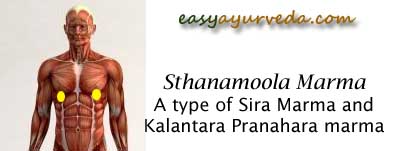Sthanamoola Marma: Components, Location, Effect Of Injury
Article by Dr Raghuram Y.S. MD (Ay) and Dr Manasa, B.A.M.S
Sthanamoola is an important Marma i.e. vital or delicate point of the body. They are 2 in number, located at the lower part of the breasts.
Sthana means breasts, Moola means roots or base, therefore Sthanamoola means those which are present at the lower part of the breasts.

Since Sthanamoola Marmas are located in the (middle part of the body), they are considered as Madhya Shareera gata Marmas. Since they are located in the chest, they are also considered under Uro-Gata Marmas.
Sthanamoola Marma
स्तनयोः अधस्ताद् द्वि अङ्गुलं उभयतः स्तनमूले, तत्र कफ पूर्ण कोष्ठतया (कास श्वासाभ्यां) म्रियते।(सु.शा.६)
Table of Contents
Location
They are 2 in number and are located one on either side in the chest region. Each Sthanamula Marma measures 2 angula in dimension. The location is the same on both right and left sides.
Categories
Categories in which the Sthanamoola Marma is included
i) Madhya Shareera Gata Marma, Uro Gata Marma (Madhya Shareera = Middle portion of the body, trunk, Uro = chest)
ii) Siraa Marma – Sthanamula marma is predominantly made up of Sira i.e. veins, which form the structural component of this Marma. The other elements namely Snayu (ligaments), Asthi (bone), Sandhi (joints) and Mamsa (muscles) are also present but in a lesser proportion.
iii) Kaalantara Praanahara Marma – (Kaalantara – Gradual, Pranahara – life taking) Sthanamula Marma is said to produce death over a period of time, gradually. The impact of injury to the sthanamoola marma may not be immediate.
Measurement
Pramana (measurement of Sthanamoola Marma) –
Sthanamula Marma occupies a space of 2 angula dimension (approximately equal to the horizontal dimension or breadth of middle segment of one’s own middle finger).
Effect of Injury
तत्र कफ पूर्ण कोष्ठतया (कास श्वासाभ्यां) म्रियते।(सु.शा.६)
Injury of Sthanamoola Marma causes gradual death. When Sthanamoola Marma is injured it leads to Kapha Poorna Koshtataa (filling up of thoracic cavity or lungs with excessive phlegm or mucus and other exudates) leading to Kasa (cough), shwaasa (dyspnoea, severe breathlessness) and gradual death.
Cause for gradual death:
- Blockage of respiratory passages and cells with phlegm
- Obstruction to the breathing and gas exchange phenomenon due to excess phlegm and exudates in the breathing passages and pathways
- Congestion of lungs with phlegm and exudates
- Deficit oxygenation of blood, deficit clearance of carbon dioxide from the blood
- A condition of systemic hypoxia i.e. less aeration to the body cells in the form of less oxygenation
- Oxygen deprivation of the cells and air hunger
- Failure of tissues and organs to thrive in an environment of deficit oxygenation
- Gradual organ failure and death
Modern perspective
Modern Perspective (Practical anatomy) of Sthanamoola Marma
Structures falling in the area of Sthanamula Marma –
Lungs
Base of the lungs (right and left lung)
Just Before Finishing
Sthanamula Marmas are located at the base of the right and left breast. Their location corresponds to the lungs. Lungs are the vital organs of aeration. The breathing and exchange of gases and oxygenation and deoxygenating of the blood takes place in these organs. When there is damage to these Marmas, excessive phlegm and liquids accumulate in the lungs. These exudates gradually gravitate towards the base of the lungs and cause congestion. This hampers the breathing and oxygenation phenomenon. The body and cells get deprived of oxygen in due course of time. This may lead to gradual death.
Click to Consult Dr Raghuram Y.S. MD (Ayu)










